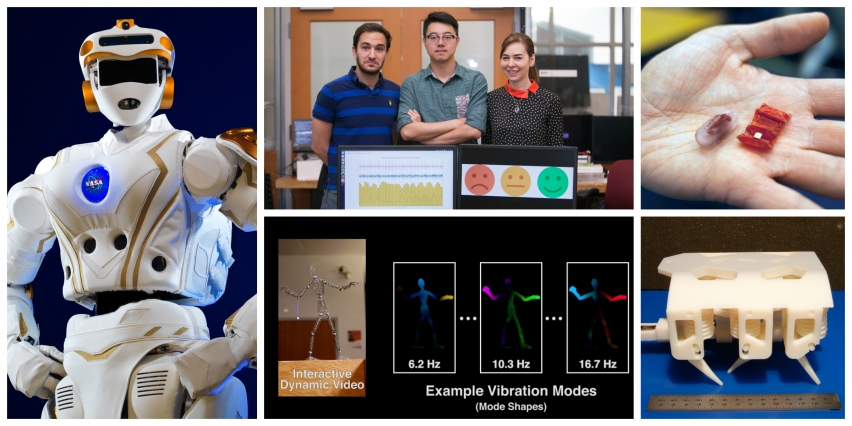
Robohub.org
Ingestible robots, glasses-free 3-D, and computers that explain themselves

In 2016, MIT CSAIL researchers worked on a range of projects in robotics, theory, wireless technology, software systems, and other disciplines. Image: CSAIL
Machines that predict the future, robots that patch wounds and wireless emotion-detectors are just a few of the exciting projects that came out of MIT’s Computer Science and Artificial Intelligence Laboratory (CSAIL) this year. Here’s a sampling of 16 highlights from 2016 that span the many computer science disciplines that make up CSAIL.
Robots for exploring Mars — and your stomach
- A team led by CSAIL director Daniela Rus developed an ingestible origami robot that unfolds in the stomach to patch wounds and remove swallowed batteries.
- Researchers are working on NASA’s humanoid robot, “Valkyrie,” who will be programmed for trips into outer space and to autonomously perform tasks.
- A 3-D printed robot was made of both solids and liquids and printed in one single step, with no assembly required.
Keeping data safe and secure
- CSAIL hosted a cyber summit that convened members of academia, industry, and government, including featured speakers Admiral Michael Rogers, director of the National Security Agency; and Andrew McCabe, deputy director of the Federal Bureau of Investigation.
- Researchers came up with a system for staying anonymous online that uses less bandwidth to transfer large files between anonymous users.
- A deep-learning system called AI2 was shown to be able to predict 85 percent of cyberattacks with the help of some human input.
Advancements in computer vision
- A new imaging technique called Interactive Dynamic Video lets you reach in and “touch” objects in videos using a normal camera.
- Researchers from CSAIL and Israel’s Weizmann Institute of Science produced a movie display called Cinema 3D that uses special lenses and mirrors to allow viewers to watch 3-D movies in a theater without having to wear those clunky 3-D glasses.
- A new deep-learning algorithm can predict human interactions more accurately than ever before, by training itself on footage from TV shows like “Desperate Housewives” and “The Office.”
- A group from MIT and Harvard University developed an algorithm that may help astronomers produce the first image of a black hole, stitching together telescope data to essentially turn the planet into one large telescope dish.
Tech to help with health
- A team produced a robot that can help schedule and assign tasks by learning from humans, in fields like medicine and the military.
- Researchers came up with an algorithm for identifying organs in fetal MRI scans to extensively evaluate prenatal health.
- A wireless device called EQ-Radio can tell if you’re excited, happy, angry, or sad, by measuring breathing and heart rhythms.
Algorithms, systems and networks
- A system called “Polaris” was found to load web pages 34 percent faster by decreasing network trips.
- A team analyzed ant-colony behavior to create better algorithms for network communication, for applications such as social networks and collective decision-making among robot swarms.
- Researchers trained neural networks to explain themselves by providing rationales for their decisions.
tags: algorithms, c-Research-Innovation, Computer Science and Artificial Intelligence Laboratory (CSAIL), Computer science and technology, computer vision, Electrical Engineering & Computer Science (eecs), Research, robotics, School of Engineering, wireless

CSAIL MIT
The Computer Science and Artificial Intelligence Laboratory – known as CSAIL – is the largest research laboratory at MIT and one of the world’s most important centers of information technology research.

CSAIL MIT
The Computer Science and Artificial Intelligence Laboratory – known as CSAIL – is the largest research laboratory at MIT and one of the world’s most important centers of information technology research.
Related posts :
Robot Talk Episode 126 – Why are we building humanoid robots?
Robot Talk
20 Jun 2025
In this special live recording at Imperial College London, Claire chatted to Ben Russell, Maryam Banitalebi Dehkordi, and Petar Kormushev about humanoid robotics.
Gearing up for RoboCupJunior: Interview with Ana Patrícia Magalhães
AIhub and Lucy Smith
18 Jun 2025
We hear from the organiser of RoboCupJunior 2025 and find out how the preparations are going for the event.
Robot Talk Episode 125 – Chatting with robots, with Gabriel Skantze
Robot Talk
13 Jun 2025
In the latest episode of the Robot Talk podcast, Claire chatted to Gabriel Skantze from KTH Royal Institute of Technology about having natural face-to-face conversations with robots.
Preparing for kick-off at RoboCup2025: an interview with General Chair Marco Simões
AIhub and Lucy Smith
12 Jun 2025
We caught up with Marco to find out what exciting events are in store at this year's RoboCup.
Interview with Amar Halilovic: Explainable AI for robotics
AIhub
10 Jun 2025
Find out about Amar's research investigating the generation of explanations for robot actions.
Robot Talk Episode 124 – Robots in the performing arts, with Amy LaViers
Robot Talk
06 Jun 2025
In the latest episode of the Robot Talk podcast, Claire chatted to Amy LaViers from the Robotics, Automation, and Dance Lab about the creative relationship between humans and machines.
Robot Talk Episode 123 – Standardising robot programming, with Nick Thompson
Robot Talk
30 May 2025
In the latest episode of the Robot Talk podcast, Claire chatted to Nick Thompson from BOW about software that makes robots easier to program.
Congratulations to the #AAMAS2025 best paper, best demo, and distinguished dissertation award winners
AIhub
29 May 2025
Find out who won the awards presented at the International Conference on Autonomous Agents and Multiagent Systems last week.


